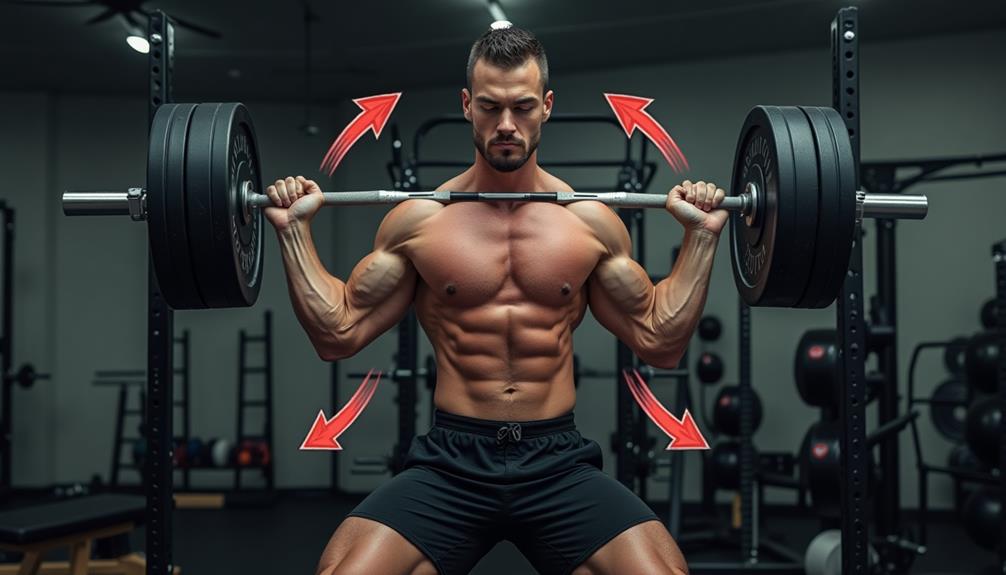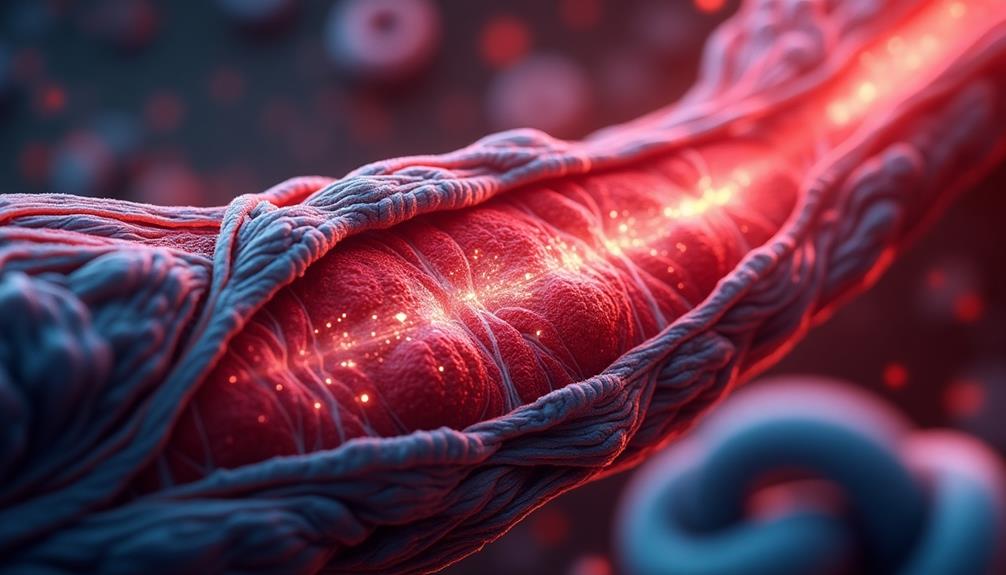The scientific principles of hypertrophy through resistance training focus on how your muscles grow. First, mechanical tension is crucial; lifting weights creates stress, prompting muscle fibers to repair and grow. Next, metabolic stress occurs when intense workouts lead to metabolite accumulation, stimulating growth hormones. Lastly, muscle damage from exercise triggers healing through satellite cells, contributing to growth. To optimize hypertrophy, pay attention to training variables like intensity and volume. Aim for moderate to high repetitions with compound movements for maximal effect. Understanding these concepts is necessary, and there's more to explore to enhance your training strategy further.
Core Insights
- Hypertrophy occurs when muscle fibers sustain damage during resistance training, prompting repair and growth through satellite cell activation.
- Mechanical tension from lifting weights is essential for stimulating hypertrophy, requiring progressive overload to see continuous muscle adaptation.
- Metabolic stress, created by intense exercise and higher repetitions, triggers hormonal responses that promote muscle growth.
- Muscle damage leads to small tears in fibers, which, when properly managed, result in stronger and larger muscles through recovery.
- Key training variables like intensity, repetitions, and exercise selection are crucial for optimizing resistance training effectiveness in promoting hypertrophy.
Understanding Hypertrophy

When you think about building muscle, understanding hypertrophy is crucial. Hypertrophy refers to the increase in muscle size through resistance training. It occurs when your muscle fibers sustain damage during workouts, leading to repair and growth. This process is essential for achieving your strength goals.
There are two primary types of hypertrophy: myofibrillar and sarcoplasmic. Myofibrillar hypertrophy focuses on increasing the density of muscle fibers, while sarcoplasmic hypertrophy boosts the volume of the muscle's energy-storing components. Both types contribute to overall muscle growth.
To promote hypertrophy, you must engage in progressive overload, which means gradually increasing the weight or intensity of your exercises. This principle guarantees your muscles continue to adapt and grow stronger over time.
Role of Mechanical Tension

Mechanical tension plays an important role in stimulating muscle hypertrophy during resistance training. When you lift weights, your muscles undergo stress, creating tension. This tension is crucial because it signals your body to adapt by increasing muscle size and strength. Proper sleep and recovery are crucial for maximizing the benefits of this tension, as quality sleep greatly impacts muscle repair and overall physical performance.
As you progressively lift heavier weights or increase resistance, the tension in your muscles intensifies. This progressive overload is key to ongoing growth. You should aim for a balance between the amount of weight lifted and the number of repetitions.
Keep in mind that maintaining proper form is essential. Poor technique can reduce tension on your muscles and increase the risk of injury. Focus on controlled movements to maximize the mechanical tension and ultimately enhance your hypertrophy results.
Metabolic Stress Explained

While mechanical tension is essential for muscle growth, metabolic stress also plays a significant role in hypertrophy. Metabolic stress refers to the accumulation of metabolites during intense exercise, which triggers cellular pathways that promote growth. This process is similar to how caffeine boosts energy and alertness, but in the context of muscle adaptation. Here's how it impacts your training:
- Increased Hormone Release: It stimulates the release of hormones like growth hormone and testosterone, vital for muscle repair and growth.
- Cellular Swelling: This occurs when fluid accumulates in muscle cells, signaling them to adapt and grow larger.
- Fatigue and Repetition: Higher repetitions at moderate weights induce more metabolic stress, leading to greater hypertrophic responses.
Muscle Damage Mechanisms

Understanding muscle damage mechanisms is important for maximizing your resistance training results. When you lift weights, you create small tears in your muscle fibers. This process is vital for muscle growth, as it stimulates repair and adaptation. Similar to how compression sleeves aid recovery, proper resistance training promotes muscle healing and growth. The level of muscle damage can be influenced by factors such as intensity and volume of exercise.
Your body responds by activating satellite cells, which help rebuild and strengthen the damaged fibers. This adaptation leads to increased muscle size and strength over time.
However, not all muscle damage is advantageous. Excessive damage can hinder recovery and lead to injury. It's important to balance intensity and volume in your workouts. Pay attention to how your body feels after training sessions. Incorporating rest and nutrition will aid recovery and promote muscle growth. By understanding these mechanisms, you can tailor your training for best results.
Key Training Variables

When it comes to maximizing hypertrophy through resistance training, several key training variables play an important role. Understanding these variables can greatly enhance your workout effectiveness.
- Intensity: This refers to the amount of weight you're lifting. Higher intensity can lead to greater muscle growth, but balance is necessary to avoid injury.
- Repetitions: The number of reps per set affects muscle fatigue and hormonal response. Aim for moderate to high reps (6-12) for ideal hypertrophy.
- Exercise Selection: Choosing the right exercises is essential. Compound movements, like squats and bench presses, engage multiple muscle groups and promote better growth.
Volume and Frequency Impact

To maximize muscle growth, you need to pay close attention to both volume and frequency in your training regimen. Volume refers to the total amount of work you perform, typically measured in sets and reps. Higher volume can lead to greater muscle hypertrophy, as it increases the time your muscles spend under tension.
Frequency, on the other hand, is how often you train a specific muscle group within a week. Training a muscle group more frequently can enhance recovery and stimulate growth. Ideally, aim for 10 to 20 sets per muscle group each week, spread across multiple sessions. Balancing both volume and frequency will help you create an effective training plan that promotes ideal muscle growth while reducing the risk of injury.
Intensity and Load Considerations

- Determine Your One-Rep Max (1RM): Knowing your 1RM helps you select the appropriate load for your training. Aim for a weight that challenges you while allowing proper form.
- Utilize Rep Ranges: Generally, 6-12 reps are ideal for hypertrophy. Adjust your load accordingly to stay within this range.
- Progressive Overload: Continuously increase your load or intensity over time. This adaptation forces your muscles to grow in response to the increased demands.
Optimizing Your Training Program

Optimizing your training program involves fine-tuning various components to maximize muscle growth and overall performance. Start by setting clear goals, whether it's building strength, increasing size, or improving endurance. Next, adjust your training frequency; typically, training a muscle group 2-3 times per week yields great results.
Focus on exercise selection, incorporating compound movements like squats and deadlifts alongside isolation exercises for balanced development. Don't forget to monitor your intensity and volume; aim for a mix of heavy loads and higher repetitions for hypertrophy.
Lastly, prioritize recovery. Verify you're getting enough sleep and nutrition to support muscle repair. By addressing these aspects, you'll optimize your training program and enhance your results effectively.
Frequently Asked Questions
How Do Genetics Influence Hypertrophy Outcomes in Resistance Training?
Genetics play a huge role in your hypertrophy outcomes. They determine muscle fiber types, recovery rates, and hormone levels. Understanding your genetic predispositions can help you tailor your training for best results and realistic expectations.
Can Hypertrophy Occur Without Heavy Lifting?
Hypertrophy's like a garden; it thrives with care, not just heavy lifting. You can achieve muscle growth through lighter weights, higher reps, and consistent tension, proving that intensity isn't solely about the load you lift.
What Role Does Nutrition Play in Muscle Growth?
Nutrition's vital for muscle growth. You need adequate protein to repair and build muscle fibers, along with carbs for energy. Don't forget healthy fats; they support overall hormone balance, enhancing your body's ability to grow effectively.
How Does Age Affect Hypertrophy Potential?
As you age, your body's ability to build muscle naturally declines. It's not the end of the line, though; with the right training and nutrition, you can still make significant gains and defy expectations.
Are There Specific Exercises That Maximize Hypertrophy?
To maximize hypertrophy, focus on compound exercises like squats, deadlifts, and bench presses. These movements engage multiple muscle groups, promoting growth. Don't forget to include isolation exercises to target specific muscles effectively. Keep your intensity high!

